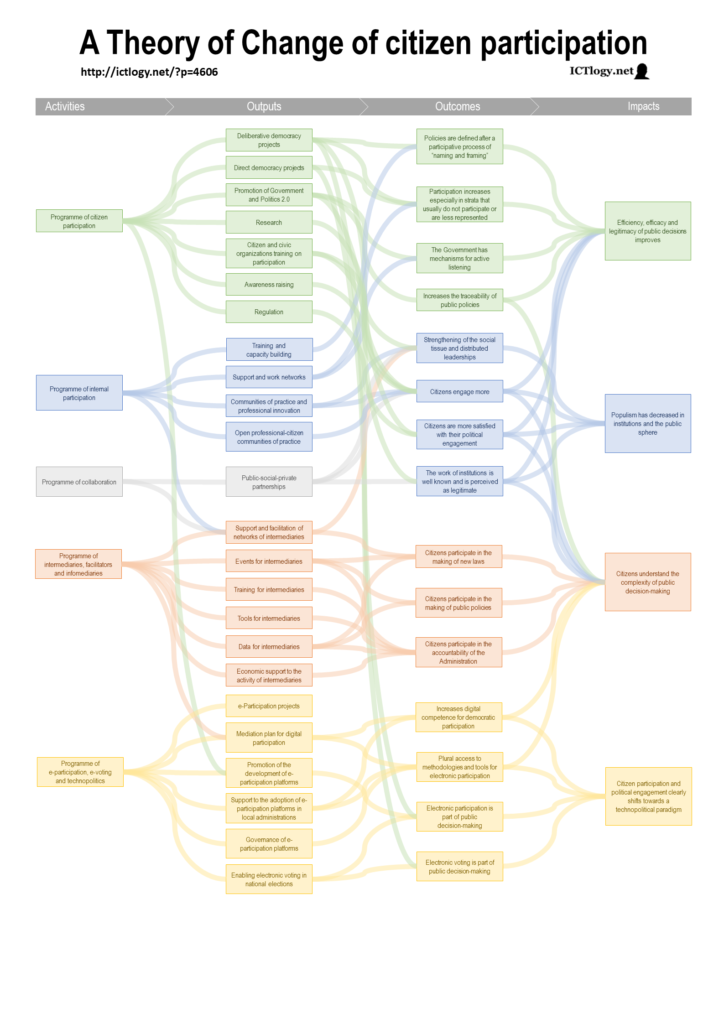In June 2018 I was appointed Director General of Citizen Participation and Electoral Processes at the Catalan Government. The directorate general had been just created. There had been a previous Directorate General of Citizen Participation which had lasted from 2003 to 2010, when it was reduced to a subsidiary internal service lacking all kind of political attributions. The work done in those years had been formidable, but too many things had passed since, especially the 15M Spanish Indignados Movement, the raise of technopolitics… and the raise of populism and fascism all across Europe.
We urgently needed a theoretical framework in which to substantiate our political strategy, so I came up with a Theory of Change of citizen participation which defined four expected impacts of our political action:
- Efficiency, efficacy and legitimacy of public decisions improves.
- Populism has decreased in institutions and the public sphere.
- Citizens understand the complexity of public decision-making.
- Citizen participation and political engagement clearly shifts towards a technopolitical paradigm.
These impacts were expected to be achieved after some outcomes resulting from some outputs grouped in five programmes:
- Programme of citizen participation.
- Programme of internal participation.
- Programme of collaboration.
- Programme of intermediaries, facilitators and infomediaries.
- Programme of e-participation, e-voting and technopolitics.
20 months after, the Theory of Change of Citizen Participation has worked quite well. But it does have some limitations, especially at the operational level —which is what the whole thing was about, to help in putting some order in our daily work.
- The first limitation deals with the fact that Electoral Processes / Representative Democracy was left outside, as it was always thought as an only “logistic” matter. It is not. Even if at the Directorate General there are two different sub-directorates —Citizen Participation, and Electoral Processes— and they are really different on the way both units work and the kind of service they have to provide, there also are some similarities and even synergies. This becomes very relevant in the field of awareness raising, dissemination and, in general, in helping people understand democracy at large. So, we should think in democratic institutions as a whole, no matter how different they may seem or work.
- Another limitation was thinking that we can transpose citizen participation instruments into the Administration just like this. We called that “Internal participation”. It simply does not work. If we want to transform internal practices, we have to (1) adapt to how the Administration works and, more important, (2) be utterly explicit about our purposes: we want to transform the Administration, not just encourage internal participation.
- The idea to approach new intermediaries is still valid. But if we address it as something in itself, it becomes detached with the rest of policies… and one ends up failing to draw a specific approach for new intermediaries, facilitators and infomediaries. It took me a full year to define what are these new intermediaries in citizen engagement, and we’ve yet to define a specific policy for them. Hence, we need to consider the whole set of actors, and address them as a collective while keeping their individual/categorical specificities.
- Same applies to e-participation, e-voting and technopolitics. Although it worked to identify some priority areas, it was also sometimes difficult not to acknowledge that everything is connected, that it all conforms a citizen participation ecosystem where all infrastructures are connected.
So, we came up with a reviewed Theory of Change of Citizen Participation (v4.2):
The main changes between v1.0 and v4.2 (yes, there were some attempts in between) can be inferred from the limitations that we listed above:
- First thing, include Electoral Participation in the theory of change. We kept it separate from other citizen participation processes (direct democracy, deliberative processes, government crowdsourcing, citizen assemblies, etc.) mainly for organizational reasons (which is a good reason, by the way), but being now within the same scheme makes some things more clear, especially the link between e-voting and e-participation, or everything related with awareness raising and understanding democratic institutions.
- The second big change is that Transformation of the Administration is now a core issue, and a very much explicit one. This has been crucial for improving the focus on knowledge management, quality issues and assessment, better alignment of training with programming, etc.
- The third and last big change is considering everything else —that is, everything but citizens and the national Administration— as an ecosystem where everything is related: municipalities, the professional sector, the informal side of citizen participation, instruments, methodologies, technologies, spaces (physical and virtual), etc. Some big, strategic programmes fit now much better and have been much better defined with this idea of ecosystem.
Briefly put, we now focus on three areas which are very well defined:
- encourage citizens participate and help them to understand;
- encourage the Administration to let itself be participated and hence transform its own organization;
- look after the ecosystem that enables citizens participation by progressively transforming the role of the Administration in it.
We believe the new scheme is easier to understand and, more important, makes it easier to work in a very focused way.




